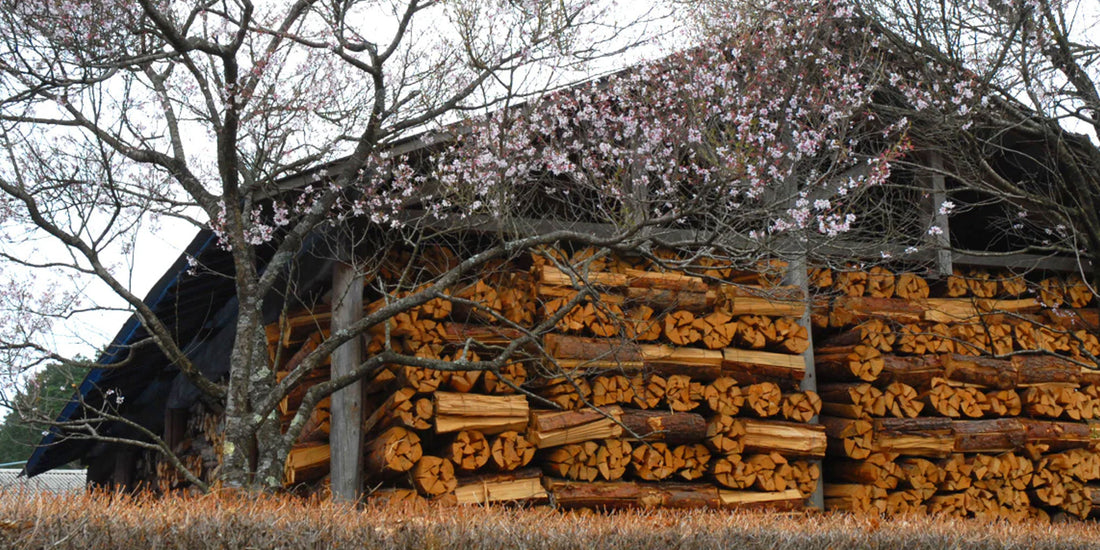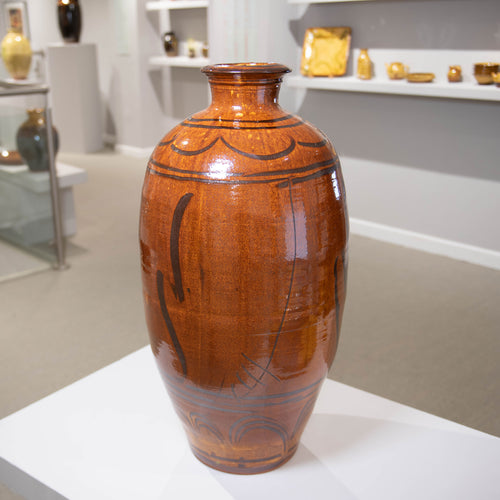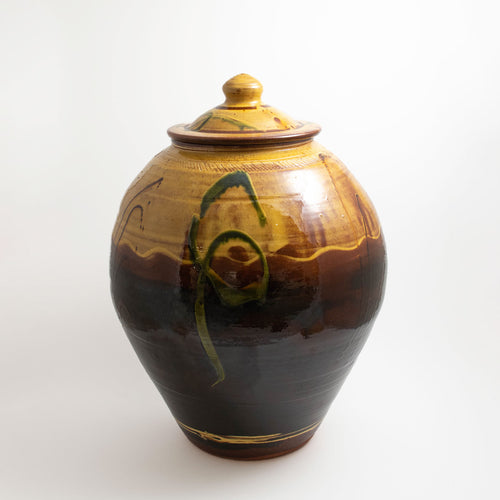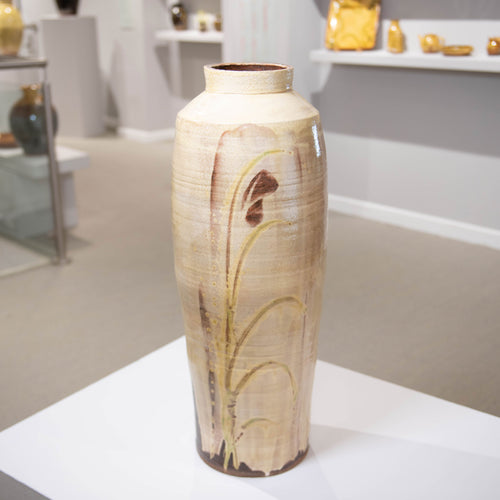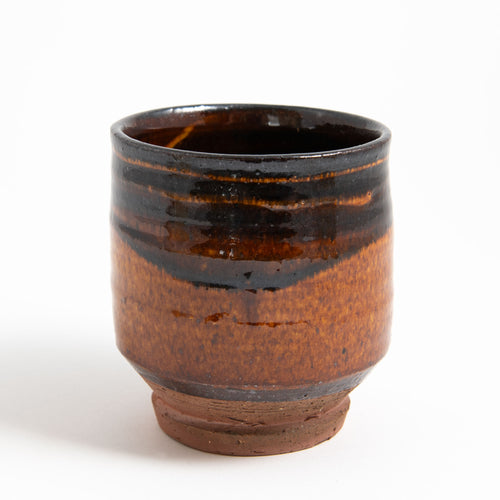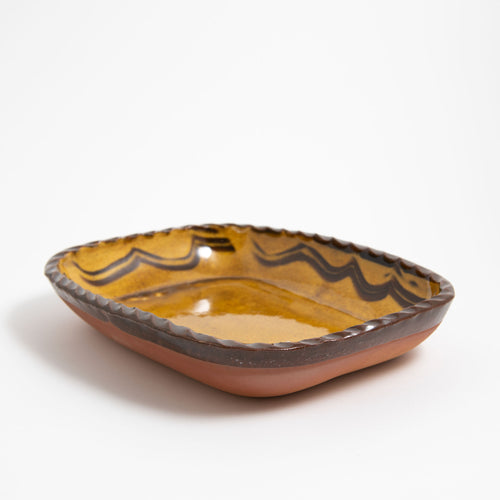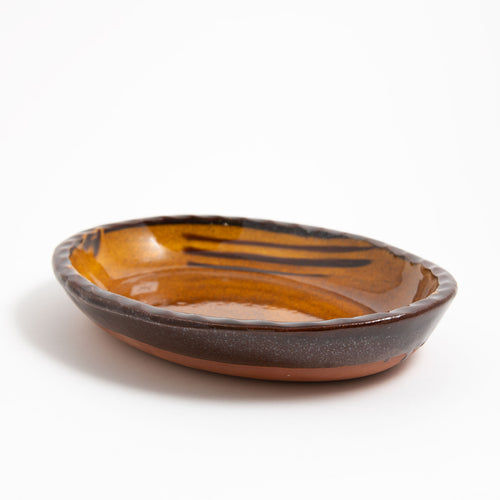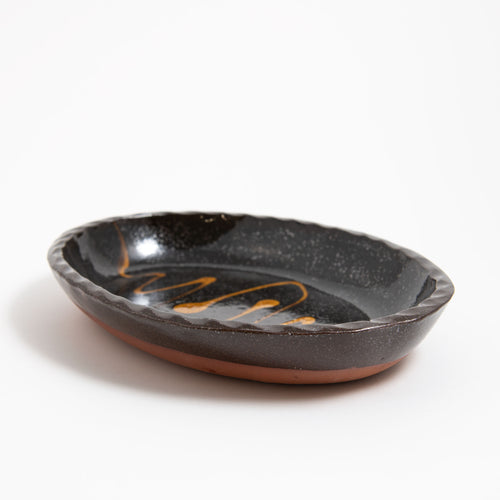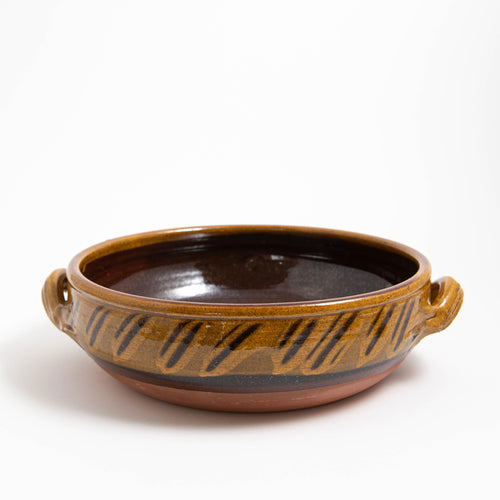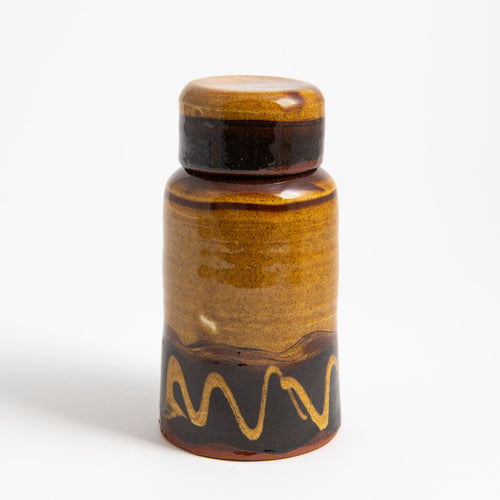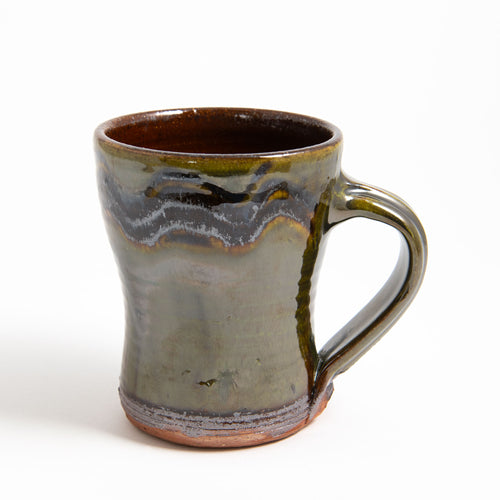Lying some 60 miles north of the swarming metropolis of Tokyo, the pottery town of Mashiko rests sleepily beneath the shallow, sloping hill of Mount Takadate. In the autumn season, from peak to foot the mountain is blanketed in a coat of changing leaves as red pine and Japanese beech shiver from green to gold, ochre, and terracotta red. It is a place of animistic spirits, of living rocks, roots, and rustling treetops. Little wonder it has attracted artists and craftsmen to its shadow for thousands of years.
 (above) Mashiko through the trees; (below) a typical Mashiko side-street
(above) Mashiko through the trees; (below) a typical Mashiko side-street

Arriving at the local train station, visitors are met at the ticket barrier by an enormous, billowing stoneware pot topped with pools of wood-ash glaze. Venture further into town and you begin to spot clay in all its forms: delicate cups and flower vases on display in shopfront showrooms; rustic domestic wares heaped high upon roadside and market stalls; crumbling clods dried and caked on tools or stored as samples in workshop sheds; wet and pliable on wooden kick-wheels as local throwers give studio demonstrations; and, elsewhere, in the growing mounds of pottery shards piled beside potters’ kilns, the skeleton wreckage evidencing all too clearly the price of failed firings.
 (above) one of the town's many overflowing piles of pottery shards
(above) one of the town's many overflowing piles of pottery shards

Clay has always been at the centre of Mashiko’s history. Early pottery fragments discovered in the outskirts of the town date back as far as the Jomon period, some 16,000 years ago at a time when local man had begun the technical process of making pots even before learning how to irrigate his crops. The first distinct Mashiko-yaki pots of a style particular to the area – emerged in the Nara period in the mid-8th century. In the following years very little was further produced in Mashiko, and its iron-rich and dynamically decorated wares remained comparatively little-known beside those of the famous kiln towns such as Bizen, Shigaraki and Seto. The story of Mashiko’s monumental success at the epicentre of Japan’s ceramic culture is an altogether more recent affair.
 (above) ceramic works by Ken Matsuzaki reflecting the natural surroundings of Mashiko hills and woodlands
(above) ceramic works by Ken Matsuzaki reflecting the natural surroundings of Mashiko hills and woodlands

In 1853 the trained potter and farmer Keisaburo Otsuka established his own, individual kiln within the town district. A local of the nearby Kasama ceramics town, Otsuka had discovered – as had early settlers before him – that the local geography of Mashiko included stoneware clay bodies naturally rich in iron oxide and kaolin minerals, ideal for making pots and glazes. Moving his family to the town while he set up his business, Otsuka became one of the first potters to synonymise the Mashiko name with ceramic trade. Given the prefecture’s proximity to Edo, now modern-day Tokyo, wares could be easily transported to the capital, supplying urban city-folk with rural, robust, utilitarian pots for use in the kitchen at home.
 (above) pots unpacked from a recent firing, their wadding bases still attached; (below) one of many ceramics boutiques
(above) pots unpacked from a recent firing, their wadding bases still attached; (below) one of many ceramics boutiques

But if any one person could lay claim to having encouraged the extraordinary mass migration of potters and craftsmen to the town over the last eighty years, it was Japan’s most celebrated potter Shoji Hamada. Having returned to his homeland after years spent working alongside Bernard Leach in St Ives, Hamada resolved to set up a workshop in Mashiko in 1930. Inspired by the Mingei folk-craft principles laid down by friend and mentor Soetsu Yanagi, and accompanied by Leach and fellow potter Kawai Kanjiro, Hamada quickly developed a worldwide reputation for reviving the faltering demand for handmade pottery in the wake of the mechanised butchery of the First World War.
 a sideview of a guest house in the Hamada compound
a sideview of a guest house in the Hamada compound
Despite espousing many of the precepts he and Yanagi had developed in their years travelling together and visiting rural potteries in Korea and Britain – anonymity of the craftsman; form following function; an aesthetic ostensibly rustic and unrefined, realised in locally sourced materials – Hamada was quick to see the benefits his newfound celebrity afforded him and the craftspeople who surrounded him. His sumptuous work, an embodiment of the core tenets of Mingei elevated to the level of fine ceramic art, commanded ever higher prices at grand public exhibitions, helping to put Mashiko on the world map in a way that no other pottery town, not even the famed six ancient kilns of Japan, had ever managed before. Even today, the greater proportion of the near-four-hundred potters and studios working from the town are heavily indebted to his ceramic style, producing lesser pastiches of what is unmistakably the work of a rare genius.
 (above) Hamada's 'noborigama' climbing kiln; (below) traditional throwing wheels in the residence's throwing space
(above) Hamada's 'noborigama' climbing kiln; (below) traditional throwing wheels in the residence's throwing space

By 1955 Hamada had been designated a ‘Living National Treasure’ by the Japanese government and was now one of the wealthiest artists in the country. His sizeable country house, nestled among trees and moss-topped rocks on a local hillside, became a major tourist attraction for would-be disciples and visiting vacationers alike, looking to observe the master at work. Beautifully designed with courtyards, dark polished wood floors and a dedicated throwing space, it has been kept as it appeared during his lifetime, relocated and rebuilt at the Mashiko Museum of Ceramic Art, while the original site now houses the studio spaces of Hamada’s son and grandson, Shinsaku and Tomoo. Today Hamada's estate stands as a place of heritage and history, cherished not only for its record of the processes and the pots that brought Mashiko its celebrated status, but also for Hamada’s own personal collection of handmade furniture, tools, ceramics and artefacts, a rich collection of culturally diverse objects that tell a mutual story of Japan’s history of craft, and indeed that of the wider world.
 (above) an interior from the Hamada estate; (below) one of a number of pieces from the master potter's collection
(above) an interior from the Hamada estate; (below) one of a number of pieces from the master potter's collection

The legacy of Hamada and his great influence on Mashiko pottery plays out in the landscape of the town. Walk further along the trundling lane past the entrance to Hamada’s retreat and you will find the home of his apprentice, the great Tatsuzo Shimaoka, who was himself appointed a Living National Treasure during his lifetime; a little further still, and you come to the workshop of Ken Matsuzaki, Shimaoka’s pupil in turn. Unlike many of the local Mashiko workshops, both Shimaoka and Matsuzaki were able to free themselves of the sometimes suffocating influence of so talented a teacher, and both have produced work worlds apart from the now ubiquitous, calligraphic brushwork and rust-red kaki glazes that made Hamada a living legend.
 (above) Ken Matsuzaki unpacking a shino work from his kiln; (below) five up-and-coming potters soon to exhibit at Goldmark
(above) Ken Matsuzaki unpacking a shino work from his kiln; (below) five up-and-coming potters soon to exhibit at Goldmark

On June 3rd later this year Goldmark will be welcoming the next generation of Mashiko potters in a major exhibition organised by Matsuzaki and with official support from the Japanese Embassy. Five up-and-coming makers representing the town – Taketoshi Ito (top middle), Shikamaru Takeshita (right), Toshihiko Takeda (bottom centre), Natsu Nishiyama (top left), and Yoshinori Hagiwara (bottom left) – will be gracing the gallery upper floor with their work, the first cultural exchange of its kind between Mashiko artists and a UK gallery.
 (above) fresh from the kiln: natural ash - 'yohen' - and shino pots by Ken Matsuzaki
(above) fresh from the kiln: natural ash - 'yohen' - and shino pots by Ken Matsuzaki

In its simple, direct, and unpretentious approach to work, the success of Mashiko lies in its remarkable ability to do away with divisions between genres: here art, craft and design become one and the same, blurred and blended in the studio production of beautiful, supremely functional, contemplative and contemporary objects. Ceramics remains its lifeblood; the town lives and breathes its processes, sometimes literally so, as when the climbing noborigama kilns are lit and the upward draft of air through flame throbs a steady pulse, inhalation and exhalation, like the beating heart of the town itself.
 a traditional cast-iron kettle for essential mid-firing refreshments
a traditional cast-iron kettle for essential mid-firing refreshments
Back in 2011, when the great earthquake rocked eastern Japan, many of these were irreparably damaged or destroyed, and it has taken some few years to rebuild kilns and confidence as lives and livelihoods are restored. Six years on, those kilns are alight again, their well-fed chambers roaring; long may they continue to burn bright.
